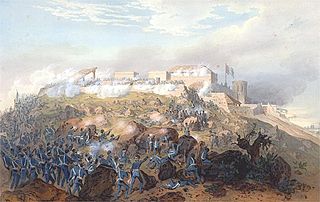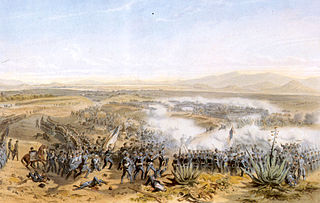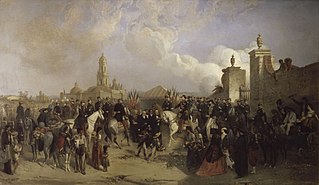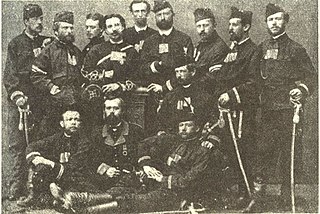 W
WThe attack against Porfirio Díaz of 1897 refers to the attack on 16 September 1897 on the Mexican president in the Alameda Central of Mexico City. The perpetrator was identified as Arnulfo Arroyo, who was imprisoned and murdered the same day by a crowd. This is considered the first lynching in Mexico.
 W
WThe Battle for Mexico City refers to the series of engagements from September 8 to September 15, 1847, in the general vicinity of Mexico City during the Mexican–American War. Included are major actions at the battles of Molino del Rey and Chapultepec, culminating with the fall of Mexico City. The U.S. Army under Winfield Scott scored a major success that ended the war.
 W
WThe Battle of Churubusco took place on August 20, 1847, while Santa Anna's army was in retreat from the Battle of Contreras or Battle of Padierna during the Mexican–American War. It was the battle where the San Patricio Battalion, made up largely of American deserters, made their last stand against U.S. forces. The U.S. Army was victorious, outnumbering more than two-to-one the defending Mexican troops. After the battle, the U.S. Army was only 5 miles (8 km) away from Mexico City. About 50 of the captured San Patricios were later hanged.
 W
WThe Battle of Contreras, also known as the Battle of Padierna, took place on 19–20 August 1847, in one of the final encounters of the Mexican–American War, as invading U.S. forces under Winfield Scott approached the Mexican capital. American forces surprised and then routed the Mexican forces General Gabriel Valencia, who had disobeyed General Antonio López de Santa Anna's orders for his forces' placement. Although the battle was an overwhelming victory for U.S. forces, there are few depictions of it in contemporary popular prints. The armies re-engaged the next day in the Battle of Churubusco.
 W
WThe Battle of Molino del Rey was one of the bloodiest engagements of the Mexican–American War as part of the Battle for Mexico City. It was fought in September 1847 between Mexican forces under General Antonio León against an American force under Major General Winfield Scott at El Molino del Rey on the fringes of Mexico City. The Americans made little progress in this battle, but the Mexican forces were unable to hold them back long enough to prevent the capture of Mexico City one week later.
 W
WThe Casa de los Azulejos or "House of Tiles" is an 18th-century Baroque palace in Mexico City, built by the Count of the Valle de Orizaba family. The building is distinguished by its facade, which is covered on three sides by blue and white tile of Puebla state. The palace remained in private hands until near the end of the 19th century. It changed hands several times before being bought by the Sanborns brothers who expanded their soda fountain/drugstore business into one of the best-recognized restaurant chains in Mexico. The house today serves as their flagship restaurant.
 W
WThe Battle of Chapultepec on 13 September 1847 was an assault by invading American forces on a small contingent of Mexican forces holding the strategically located Chapultepec Castle just outside Mexico City. The building, sitting atop a 200-ft (60-m) hill, was an important position for the defense of the city. For the campaign to take Mexico City, of which the Battle of Chapultepec is a part, General Winfield Scott's U.S. Army totaled 7,200 men. General Antonio López de Santa Anna deployed Mexican forces to several sites to defend the capital, so just 880 troops, including military cadets of the Military Academy defended the position at Chapultepec against 2,000 U.S. forces. The Mexican forces' loss opened the way to take the center of Mexico City. In Mexican history, the battle is cast as the story of the brave deaths of six cadets, the Niños Héroes, who leapt to their deaths rather than be taken captive, with one wrapping himself in the Mexican flag. The U.S. has many depictions of the battle from their point of view. Although it lasted only about 60–90 minutes, the battle has great importance in the histories of both countries.
 W
WThe 1863 Capture of Mexico City by French led forces took place on 10 June 1863 in Mexico City.
 W
WThe Battle for Mexico City refers to the series of engagements from September 8 to September 15, 1847, in the general vicinity of Mexico City during the Mexican–American War. Included are major actions at the battles of Molino del Rey and Chapultepec, culminating with the fall of Mexico City. The U.S. Army under Winfield Scott scored a major success that ended the war.
 W
WThe Siege of Mexico City was an 1867 military engagement in the Second French intervention in Mexico between Mexican Republican forces, aided by the United States, and Emperor Maximilian's troops, aided by the French Empire and Austria-Hungary, encompassing in the siege of the city. It was the last armed conflict of the Second Mexican Empire and the fall of the city resulted in the transition of the Empire into the Republic led by Benito Juárez.
 W
WThe National Palace is the seat of the federal executive in Mexico. It is located on Mexico City's main square, the Plaza de la Constitución. This site has been a palace for the ruling class of Mexico since the Aztec Empire, and much of the current palace's building materials are from the original one that belonged to the 16th century leader Moctezuma II.
 W
WOld Portal de Mercaderes in the historic center of Mexico City was and is the west side of the main plaza. This side of the plaza has been occupied by commercial structures since the Spanish Conquest of Mexico in 1521. Today the west side of the square is dominated by two sets of buildings with Madero Street dividing them as it runs west from the Zocalo to the Palace of Bellas Artes. The buildings on the north side of Madero is occupied by offices on the upper floors and shops at ground level. The southside buildings are dominated on the ground floor by fine jewelry stores, marking the beginning of the "Centro Joyero Zocalo." This center extends west for two block engulfing Palma Street between Madero and 16 de Septiembre streets. Most of the upper floors of the buildings here are occupied by rooms associated with the Hotel de Ciudad de Mexico and the Hotel Majestic.